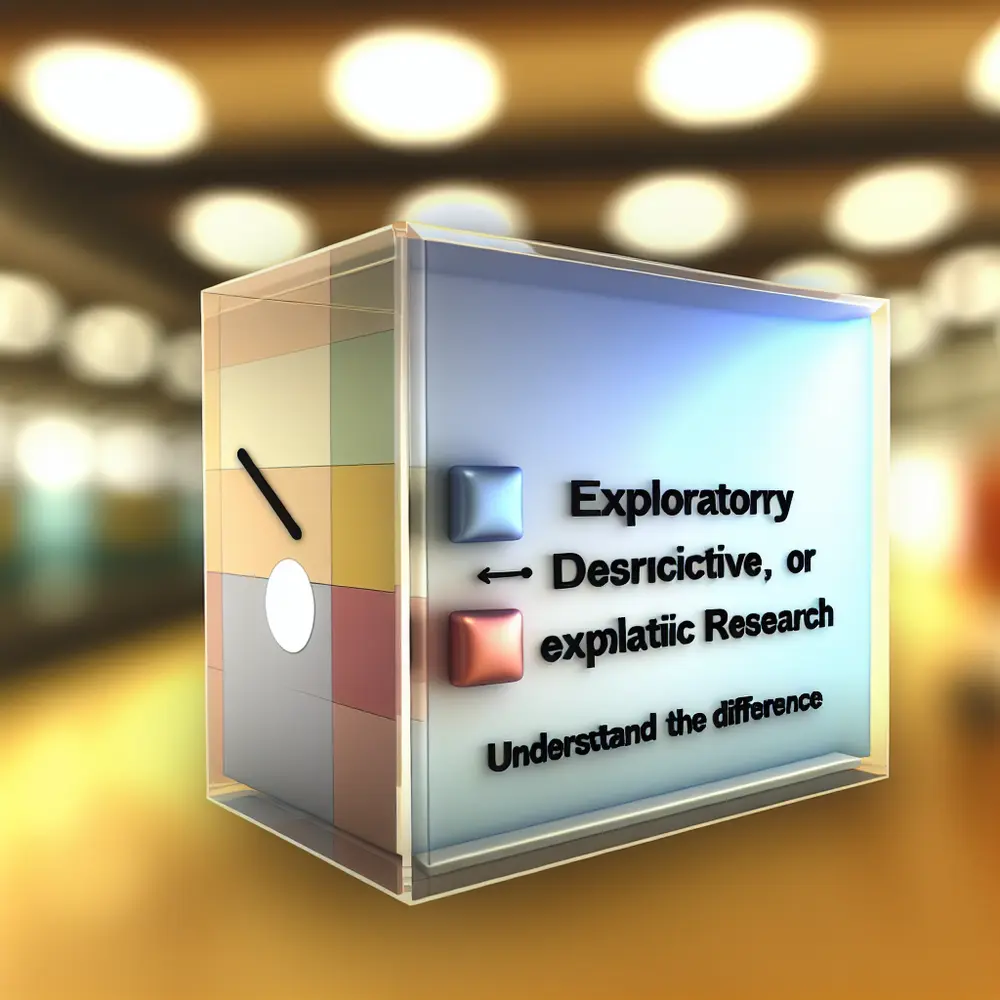Introduction
Research plays a pivotal role across multiple sectors, delivering insights that guide significant decisions. For analysts, marketers, and students, comprehending the various types of research is essential for excelling in data analysis and market research. Each type serves a specific purpose, adapting to the study’s objectives.
You embark on exploratory research as the initial step, gathering preliminary information when the problem remains unclear. This foundational research generates ideas and hypotheses, supporting researchers in articulating issues effectively. Analysts utilize techniques like interviews and focus groups to explore new territories and understand overlooked market needs.
Descriptive research complements this by outlining detailed accounts of specific phenomena. It often includes quantifiable metrics that lead to deep data analysis, a favorite among marketers aiming to grasp customer behavior, preferences, and demographics. In this transformative landscape, mastering these research types enhances your decision-making prowess.
What is Exploratory Research?
Exploratory research sets a crucial stage in the initial phases of data collection when little information is available. This open-ended approach allows researchers to investigate a problem’s various dimensions flexibly. Its significance lies in uncovering insights that can direct further analysis.
For example, imagine the marketing team at AgroTech Innovations, which conducted exploratory research using focus groups. They uncovered unanticipated consumer concerns about organic products, leading to the refinement of their marketing strategy. Consequently, they achieved a 30% increase in customer engagement.
Through qualitative methods such as interviews and open-ended surveys, exploratory research empowers analysts to gain a deeper understanding of participant perspectives. This adaptability is instrumental for marketers seeking to inform their strategies based on emerging insights.
Moreover, this research type identifies gaps in existing business intelligence systems. Companies like GreenPan Corporation have employed exploratory studies to highlight unforeseen challenges in product development, leading them to pivot their strategies effectively.
The flexibility inherent in exploratory research fuels hypothesis generation. Instead of merely testing ideas, analysts ask new questions, identifying variables that could lead to innovative solutions. This process positions exploratory research as a precursor to more structured studies, setting the stage for actionable outcomes.
Understanding Descriptive Research
Descriptive research is essential for portraying an accurate snapshot of specific populations or phenomena. This methodology emphasizes data collection and presentation, enabling analysts and marketers to highlight trends and understand market conditions effectively.
For instance, the analytics team at Retail Corp utilized descriptive surveys to assess customer demographics. By analyzing data, they centered their marketing strategies around identified preferences, leading to a 25% increase in campaign effectiveness.
The primary objective of descriptive research is to gather comprehensive data that reflects the current state of affairs. It asks “what,” “where,” and “when,” not “why,” which is crucial for informed decision-making.
Descriptive analysis aids in uncovering patterns within collected data, allowing businesses to forecast market changes. Using these insights, Tech Solutions anticipated a significant shift in preferences, successfully adapting their product line accordingly.
However, analysts must acknowledge its limitations: descriptive research does not explain cause-and-effect relationships. This constraint often leads professionals to seek explanatory research to dive deeper into observed trends.
The Role of Explanatory Research
Explanatory research plays a vital role in clarifying and understanding the causes behind observed phenomena. By establishing relationships between variables, this type of research aids analysts and marketers in making informed decisions.
In a notable case, HealthPlus Pharma implemented explanatory research to determine the impact of digital marketing campaigns on sales. Their findings unveiled a 40% increase in conversion rates linked to targeted customer engagement strategies.
Explanatory research enhances data analysis by uncovering the underlying factors influencing trends. Analysts employ statistical methods to identify causal relationships, boosting the findings’ reliability and ensuring decisions are evidence-based.
This research type is critical for understanding consumer behavior. By examining what prompts purchasing decisions, companies can refine their offerings and marketing messages. As a result, FashionHub optimized its product lines based on insights from explanatory research, leading to a 15% increase in customer loyalty.
Ultimately, explanatory research bridges the gap between data collection and actionable insights, guiding businesses in navigating market dynamics effectively.
Comparing Exploratory, Descriptive, and Explanatory Research
Research is indispensable in various fields, including market research and business intelligence. Understanding the differences among exploratory, descriptive, and explanatory research is crucial for effective data utilization.
Exploratory research serves as a foundation for identifying complex problems, while descriptive research provides a structured analysis of the phenomenon. For instance, after conducting exploratory research, AutoTech transitioned into descriptive studies to quantify customer preferences, revealing significant insights that shifted their product offerings.
On the other hand, explanatory research establishes causal relationships, confirming or refuting hypotheses formed during earlier stages. This comprehensive approach enables organizations to anticipate market dynamics effectively. For example, EcoClean Services utilized explanatory methods to enhance their marketing efforts, resulting in a notable 20% increase in service uptake.
The unique strengths of each research type contribute valuable insights for decision-making. While exploratory research identifies opportunities, descriptive illuminates market characteristics, and explanatory provides clarity for strategic planning.
In summary, knowing these research types allows analysts and marketers to gather valuable insights and drive better business outcomes.
Applications in Market Research and Business Intelligence
Understanding research types is crucial for effective market research and business intelligence. Each type—exploratory, descriptive, and explanatory—guides analysts and marketers to derive actionable insights.
Typically, exploratory research is employed in the initial stages to gather qualitative data, unveiling potential patterns. An organization like WellNest utilized this type to explore new health trends, discovering key motivations behind consumer behavior.
Conversely, descriptive research quantifies characteristics, employing structured surveys and statistical analysis. This technique enables businesses to pinpoint trends, leading to better-informed decisions. For example, TravelDeals relied on descriptive research to capture demographic insights, ultimately refining their promotional strategies.
Explanatory research examines cause-and-effect relationships in consumers’ actions. Organizations depend on this type when needing to analyze marketing strategy effectiveness. An example is Foodie Inc., which tested how promotional campaigns impacted sales, producing insights that heightened their transactional strategies.
Integrating these research types can significantly enhance business intelligence, leading to informed decision-making and strategic recommendations. By mastering the distinctions and applications of each type, marketers can exceed customer expectations and remain competitive in a rapidly changing environment.
Selecting the Right Type of Research for Your Project
Choosing the right research type is essential for obtaining meaningful results. The three primary types—exploratory, descriptive, and explanatory—each serve specific purposes, enabling effective alignment with your project’s objectives.
Exploratory research is perfect for initial stages, facilitating a general understanding of the subject. Companies like ByteTech thrive by utilizing qualitative methods to shape future studies based on user input gathered through interviews.
In contrast, descriptive research provides a structured understanding of the observed phenomenon with quantifiable data. This method is crucial for marketers like SalesPlus, who systematically document consumer preferences to refine their product offerings.
Explanatory research follows more rigorous methods to establish cause-and-effect relationships, enabling firms to validate theories and inform significant operational strategies. For example, BeautyWave examined the effects of social media campaigns on brand perception, solidifying their marketing approach based on precise findings.
Understanding the specific goals of your project allows you to leverage each research type effectively. This strategic alignment not only enhances data analysis but also drives effective decision-making in today’s dynamic marketplace. Improving decision-making is crucial in a competitive landscape.
Conclusion: The Importance of Clarity in Research
Comprehending various research types is vital for analysts, marketers, and students. Clarity in methodology increases data analysis quality, facilitating effective decision-making. By differentiating exploratory, descriptive, and explanatory research, you can select the right approach for specific objectives.
Exploratory research uncovers insights in new areas with limited information, which is particularly valuable for identifying consumer behavior trends. By employing this research type, companies can engage effectively with their target markets.
Descriptive research captures the current state of the market, producing systematic snapshots essential for business intelligence. Companies that leverage this type can quantify market features, leading to data-driven marketing strategies.
Explanatory research helps connect observed phenomena with their underlying causes. For marketers, this research enhances understanding of consumer decision-making, optimizing product positioning. Investments made in clear research methodologies save time and resources while improving overall performance. By utilizing omnichannel solutions, businesses can enhance their customer service while improving insights.
In conclusion, embracing diverse research methodologies ensures robust data analysis, refining marketing strategies and driving organizational success.
Further Reading and Resources
Exploring various types of research is vital for professionals enhancing their data analysis skills. Understanding exploratory, descriptive, and explanatory research distinctions improves methodology selection for projects.
Engage with resources tailored for various research approaches. For exploratory research, consider “Qualitative Research Methods” to gain valuable insights. For descriptive research, “Research Design: Qualitative, Quantitative, and Mixed Methods Approaches” offers essential guidance.
For deeper knowledge in explanatory research, explore “Causation and Correlation: A Comprehensive Guide” to facilitate understanding of causal relationships. Additionally, platforms like Nexloo offer omnichannel solutions to aid market researchers, enhancing the data collection experience.
Online courses from organizations like Coursera and edX also provide foundational concepts in research design and data analysis. Staying informed on research methodologies is vital for making data-driven decisions and achieving business objectives.









